Abstract
Radiation and chemical reactions that give rise to free radicals cause the formation of highly cytotoxic base propenals, degradation products of DNA. Human glutathione transferases (GSTs; RX:glutathione R-transferase, EC 2.5.1.18) of classes Alpha, Mu, and Pi were shown to promote the conjugation of glutathione with base propenals and related alkenes. GST P1-1 was particularly active in catalyzing the reactions with the propenal derivatives, and adenine propenal was the substrate giving the highest activity. The catalytic efficiency of GST P1-1 with adenine propenal (kcat/Km = 7.7 x 10(5) M-1.s-1) is the highest so far reported with any substrate for this enzyme. In general, GST A1-1 and GST M1-1, in contrast to GST P1-1, were more active with 4-hydroxyalkenals (products of lipid peroxidation) than with base propenals. The adduct resulting from the Michael addition of glutathione to the alkene function of one of the base propenals (adenine propenal) was identified by mass spectrometry. At the cellular level, GST P1-1 was shown to provide protection against alpha, beta-unsaturated aldehydes. GST P1-1 added to the culture medium of HeLa cells augmented the protective effect of glutathione against the toxicity of adenine propenal and thymine propenal. No protective effect of the enzyme was observed in the presence of the competitive inhibitor S-hexylglutathione. GST P1-1 introduced into Hep G2 cells by electroporation was similarly found to increase their resistance to acrolein. The results show that glutathione transferases may play an important role in cellular detoxication of electrophilic alpha, beta-unsaturated carbonyl compounds produced by radical reactions, lipid peroxidation, ionizing radiation, and drug metabolism.
Full text
PDF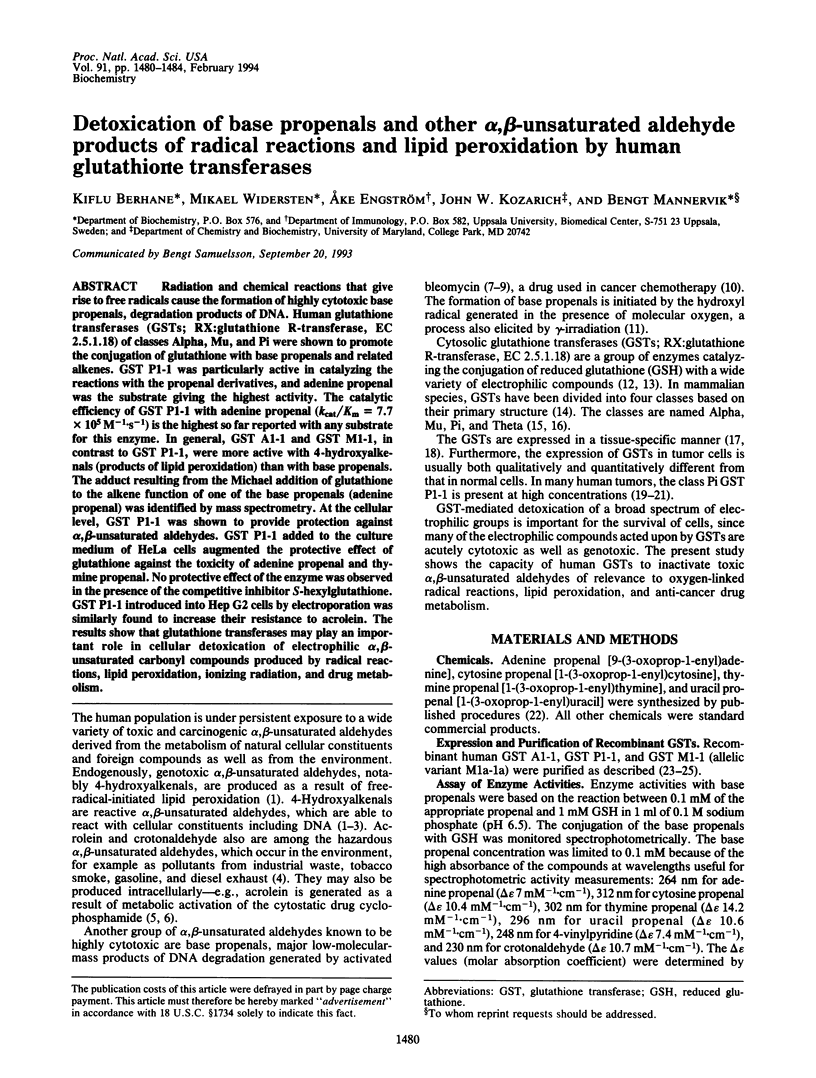
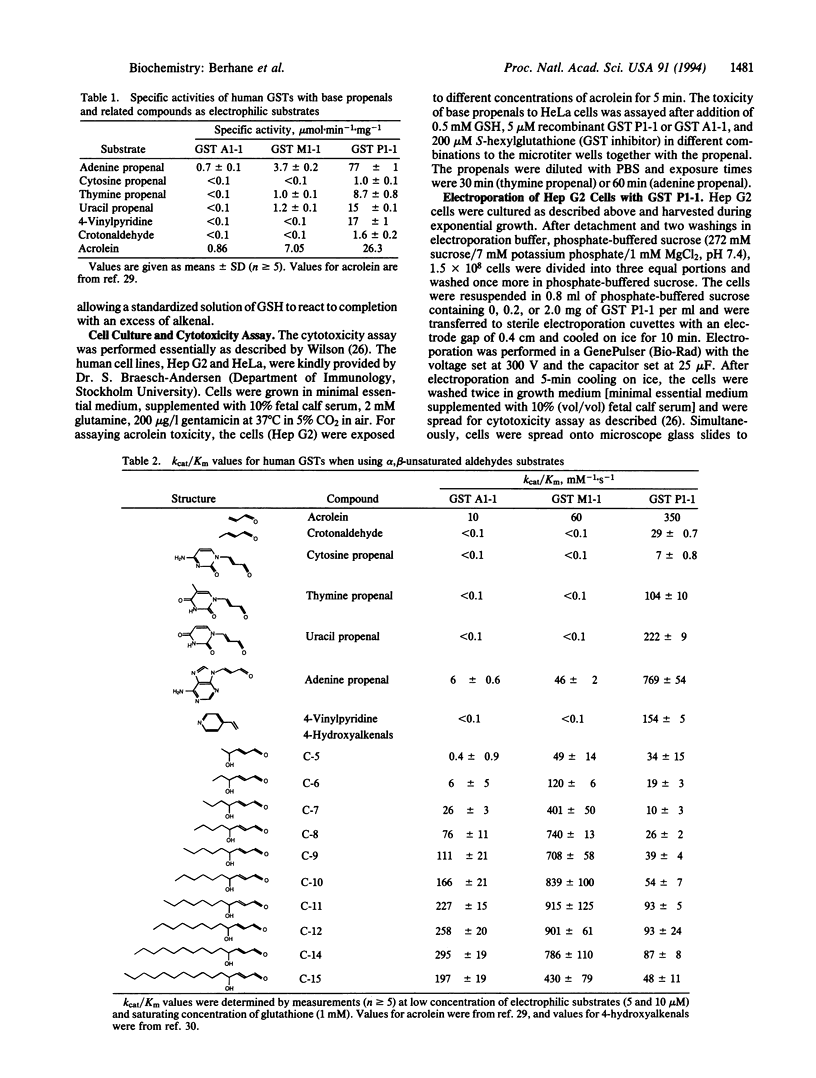
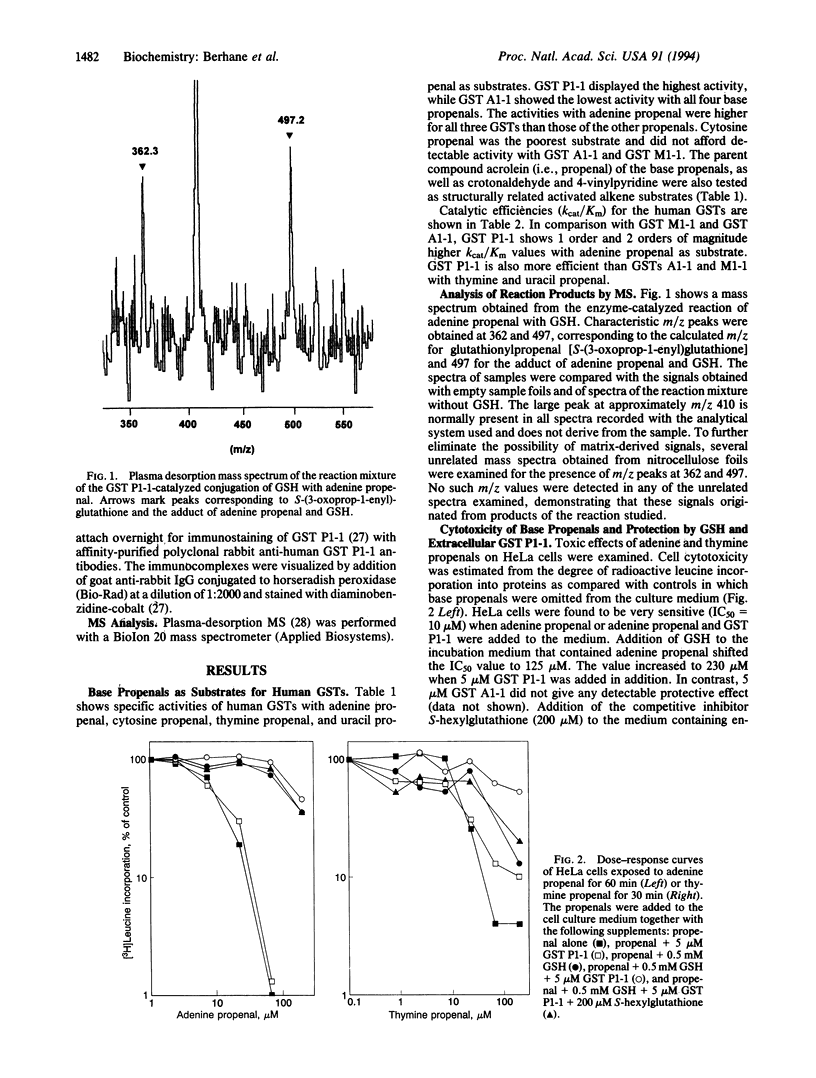
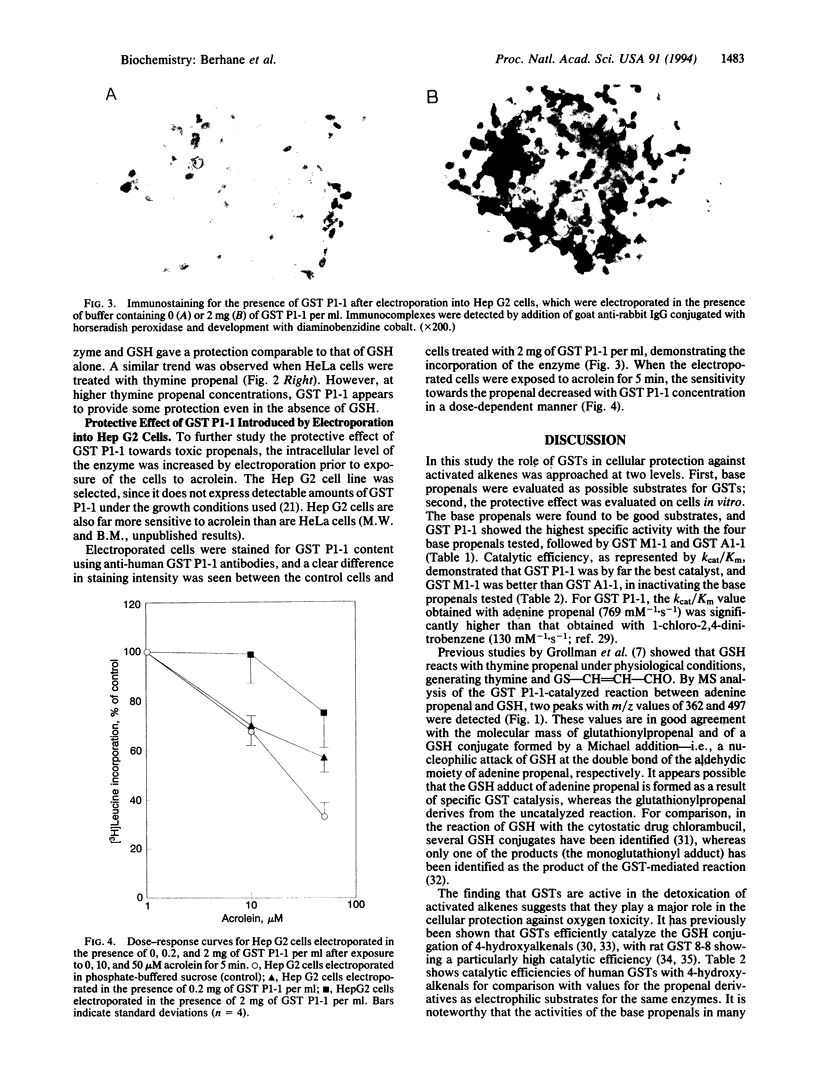
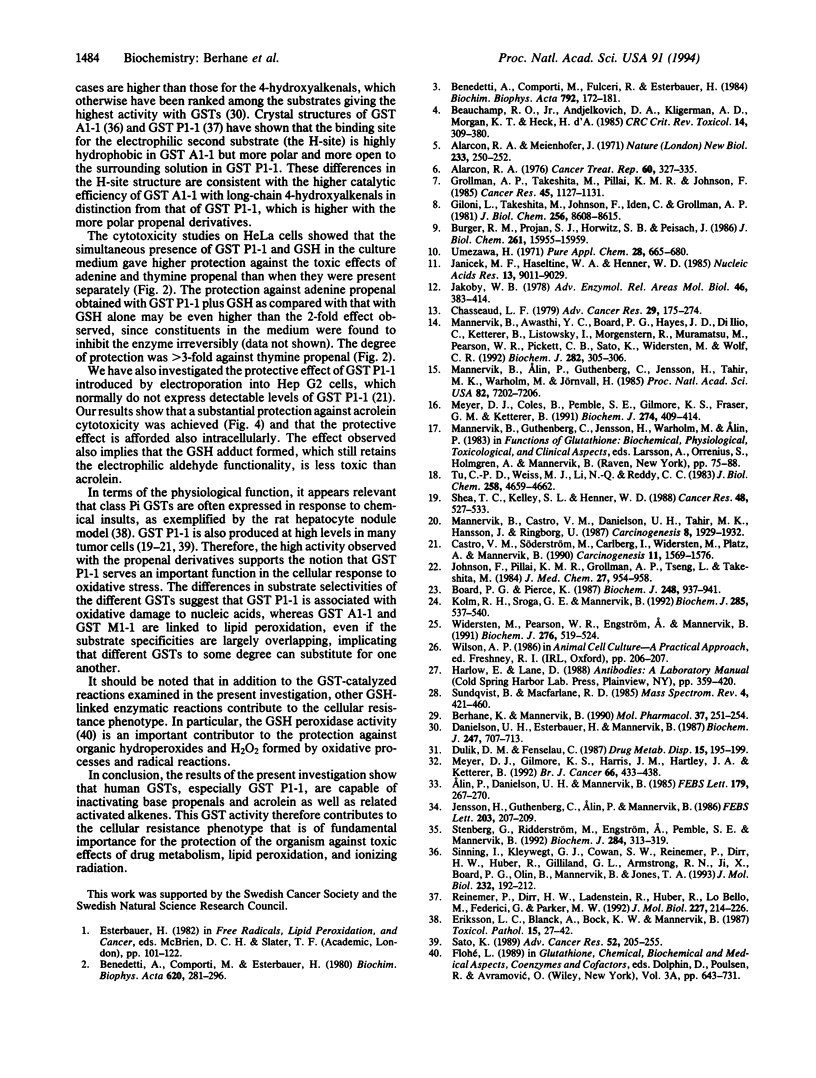
Images in this article
Selected References
These references are in PubMed. This may not be the complete list of references from this article.
- Alarcon R. A. Studies on the in vivo formation of acrolein: 3-hydroxy-propylmercapturic acid as an index of cyclophosphamide (NSC-26271) activation. Cancer Treat Rep. 1976 Apr;60(4):327–335. [PubMed] [Google Scholar]
- Alin P., Danielson U. H., Mannervik B. 4-Hydroxyalk-2-enals are substrates for glutathione transferase. FEBS Lett. 1985 Jan 7;179(2):267–270. doi: 10.1016/0014-5793(85)80532-9. [DOI] [PubMed] [Google Scholar]
- Beauchamp R. O., Jr, Andjelkovich D. A., Kligerman A. D., Morgan K. T., Heck H. D. A critical review of the literature on acrolein toxicity. Crit Rev Toxicol. 1985;14(4):309–380. doi: 10.3109/10408448509037461. [DOI] [PubMed] [Google Scholar]
- Benedetti A., Comporti M., Esterbauer H. Identification of 4-hydroxynonenal as a cytotoxic product originating from the peroxidation of liver microsomal lipids. Biochim Biophys Acta. 1980 Nov 7;620(2):281–296. doi: 10.1016/0005-2760(80)90209-x. [DOI] [PubMed] [Google Scholar]
- Benedetti A., Comporti M., Fulceri R., Esterbauer H. Cytotoxic aldehydes originating from the peroxidation of liver microsomal lipids. Identification of 4,5-dihydroxydecenal. Biochim Biophys Acta. 1984 Feb 9;792(2):172–181. doi: 10.1016/0005-2760(84)90219-4. [DOI] [PubMed] [Google Scholar]
- Berhane K., Mannervik B. Inactivation of the genotoxic aldehyde acrolein by human glutathione transferases of classes alpha, mu, and pi. Mol Pharmacol. 1990 Feb;37(2):251–254. [PubMed] [Google Scholar]
- Board P. G., Pierce K. Expression of human glutathione S-transferase 2 in Escherichia coli. Immunological comparison with the basic glutathione S-transferases isoenzymes from human liver. Biochem J. 1987 Dec 15;248(3):937–941. doi: 10.1042/bj2480937. [DOI] [PMC free article] [PubMed] [Google Scholar]
- Burger R. M., Projan S. J., Horwitz S. B., Peisach J. The DNA cleavage mechanism of iron-bleomycin. Kinetic resolution of strand scission from base propenal release. J Biol Chem. 1986 Dec 5;261(34):15955–15959. [PubMed] [Google Scholar]
- Castro V. M., Söderström M., Carlberg I., Widersten M., Platz A., Mannervik B. Differences among human tumor cell lines in the expression of glutathione transferases and other glutathione-linked enzymes. Carcinogenesis. 1990 Sep;11(9):1569–1576. doi: 10.1093/carcin/11.9.1569. [DOI] [PubMed] [Google Scholar]
- Chasseaud L. F. The role of glutathione and glutathione S-transferases in the metabolism of chemical carcinogens and other electrophilic agents. Adv Cancer Res. 1979;29:175–274. doi: 10.1016/s0065-230x(08)60848-9. [DOI] [PubMed] [Google Scholar]
- Danielson U. H., Esterbauer H., Mannervik B. Structure-activity relationships of 4-hydroxyalkenals in the conjugation catalysed by mammalian glutathione transferases. Biochem J. 1987 Nov 1;247(3):707–713. doi: 10.1042/bj2470707. [DOI] [PMC free article] [PubMed] [Google Scholar]
- Dulik D. M., Fenselau C. Conversion of melphalan to 4-(glutathionyl)phenylalanine. A novel mechanism for conjugation by glutathione-S-transferases. Drug Metab Dispos. 1987 Mar-Apr;15(2):195–199. [PubMed] [Google Scholar]
- Eriksson L. C., Blanck A., Bock K. W., Mannervik B. Metabolism of xenobiotics in hepatocyte nodules. Toxicol Pathol. 1987;15(1):27–42. doi: 10.1177/019262338701500104. [DOI] [PubMed] [Google Scholar]
- Giloni L., Takeshita M., Johnson F., Iden C., Grollman A. P. Bleomycin-induced strand-scission of DNA. Mechanism of deoxyribose cleavage. J Biol Chem. 1981 Aug 25;256(16):8608–8615. [PubMed] [Google Scholar]
- Grollman A. P., Takeshita M., Pillai K. M., Johnson F. Origin and cytotoxic properties of base propenals derived from DNA. Cancer Res. 1985 Mar;45(3):1127–1131. [PubMed] [Google Scholar]
- Jakoby W. B. The glutathione S-transferases: a group of multifunctional detoxification proteins. Adv Enzymol Relat Areas Mol Biol. 1978;46:383–414. doi: 10.1002/9780470122914.ch6. [DOI] [PubMed] [Google Scholar]
- Janicek M. F., Haseltine W. A., Henner W. D. Malondialdehyde precursors in gamma-irradiated DNA, deoxynucleotides and deoxynucleosides. Nucleic Acids Res. 1985 Dec 20;13(24):9011–9029. doi: 10.1093/nar/13.24.9011. [DOI] [PMC free article] [PubMed] [Google Scholar]
- Jensson H., Guthenberg C., Alin P., Mannervik B. Rat glutathione transferase 8-8, an enzyme efficiently detoxifying 4-hydroxyalk-2-enals. FEBS Lett. 1986 Jul 28;203(2):207–209. doi: 10.1016/0014-5793(86)80743-8. [DOI] [PubMed] [Google Scholar]
- Johnson F., Pillai K. M., Grollman A. P., Tseng L., Takeshita M. Synthesis and biological activity of a new class of cytotoxic agents: N-(3-oxoprop-1-enyl)-substituted pyrimidines and purines. J Med Chem. 1984 Aug;27(8):954–958. doi: 10.1021/jm00374a004. [DOI] [PubMed] [Google Scholar]
- Kolm R. H., Sroga G. E., Mannervik B. Participation of the phenolic hydroxyl group of Tyr-8 in the catalytic mechanism of human glutathione transferase P1-1. Biochem J. 1992 Jul 15;285(Pt 2):537–540. doi: 10.1042/bj2850537. [DOI] [PMC free article] [PubMed] [Google Scholar]
- Mannervik B., Alin P., Guthenberg C., Jensson H., Tahir M. K., Warholm M., Jörnvall H. Identification of three classes of cytosolic glutathione transferase common to several mammalian species: correlation between structural data and enzymatic properties. Proc Natl Acad Sci U S A. 1985 Nov;82(21):7202–7206. doi: 10.1073/pnas.82.21.7202. [DOI] [PMC free article] [PubMed] [Google Scholar]
- Mannervik B., Awasthi Y. C., Board P. G., Hayes J. D., Di Ilio C., Ketterer B., Listowsky I., Morgenstern R., Muramatsu M., Pearson W. R. Nomenclature for human glutathione transferases. Biochem J. 1992 Feb 15;282(Pt 1):305–306. doi: 10.1042/bj2820305. [DOI] [PMC free article] [PubMed] [Google Scholar]
- Mannervik B., Castro V. M., Danielson U. H., Tahir M. K., Hansson J., Ringborg U. Expression of class Pi glutathione transferase in human malignant melanoma cells. Carcinogenesis. 1987 Dec;8(12):1929–1932. doi: 10.1093/carcin/8.12.1929. [DOI] [PubMed] [Google Scholar]
- Meyer D. J., Coles B., Pemble S. E., Gilmore K. S., Fraser G. M., Ketterer B. Theta, a new class of glutathione transferases purified from rat and man. Biochem J. 1991 Mar 1;274(Pt 2):409–414. doi: 10.1042/bj2740409. [DOI] [PMC free article] [PubMed] [Google Scholar]
- Meyer D. J., Gilmore K. S., Harris J. M., Hartley J. A., Ketterer B. Chlorambucil-monoglutathionyl conjugate is sequestered by human alpha class glutathione S-transferases. Br J Cancer. 1992 Sep;66(3):433–438. doi: 10.1038/bjc.1992.292. [DOI] [PMC free article] [PubMed] [Google Scholar]
- Reinemer P., Dirr H. W., Ladenstein R., Huber R., Lo Bello M., Federici G., Parker M. W. Three-dimensional structure of class pi glutathione S-transferase from human placenta in complex with S-hexylglutathione at 2.8 A resolution. J Mol Biol. 1992 Sep 5;227(1):214–226. doi: 10.1016/0022-2836(92)90692-d. [DOI] [PubMed] [Google Scholar]
- Sato K. Glutathione transferases as markers of preneoplasia and neoplasia. Adv Cancer Res. 1989;52:205–255. doi: 10.1016/s0065-230x(08)60214-6. [DOI] [PubMed] [Google Scholar]
- Shea T. C., Kelley S. L., Henner W. D. Identification of an anionic form of glutathione transferase present in many human tumors and human tumor cell lines. Cancer Res. 1988 Feb 1;48(3):527–533. [PubMed] [Google Scholar]
- Sinning I., Kleywegt G. J., Cowan S. W., Reinemer P., Dirr H. W., Huber R., Gilliland G. L., Armstrong R. N., Ji X., Board P. G. Structure determination and refinement of human alpha class glutathione transferase A1-1, and a comparison with the Mu and Pi class enzymes. J Mol Biol. 1993 Jul 5;232(1):192–212. doi: 10.1006/jmbi.1993.1376. [DOI] [PubMed] [Google Scholar]
- Stenberg G., Ridderström M., Engström A., Pemble S. E., Mannervik B. Cloning and heterologous expression of cDNA encoding class alpha rat glutathione transferase 8-8, an enzyme with high catalytic activity towards genotoxic alpha,beta-unsaturated carbonyl compounds. Biochem J. 1992 Jun 1;284(Pt 2):313–319. doi: 10.1042/bj2840313. [DOI] [PMC free article] [PubMed] [Google Scholar]
- Tu C. P., Weiss M. J., Li N. Q., Reddy C. C. Tissue-specific expression of the rat glutathione S-transferases. J Biol Chem. 1983 Apr 25;258(8):4659–4662. [PubMed] [Google Scholar]
- Umezawa H. Natural and artificial bleomycins: chemistry and antitumor activities. Pure Appl Chem. 1971;28(4):665–680. doi: 10.1351/pac197128040665. [DOI] [PubMed] [Google Scholar]
- Widersten M., Pearson W. R., Engström A., Mannervik B. Heterologous expression of the allelic variant mu-class glutathione transferases mu and psi. Biochem J. 1991 Jun 1;276(Pt 2):519–524. doi: 10.1042/bj2760519. [DOI] [PMC free article] [PubMed] [Google Scholar]



